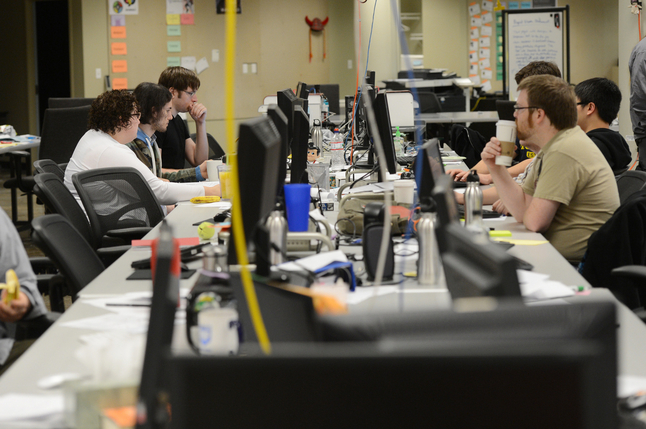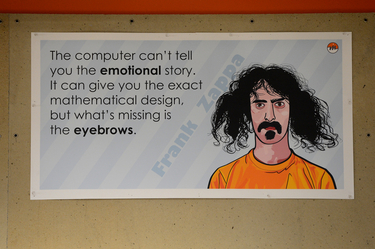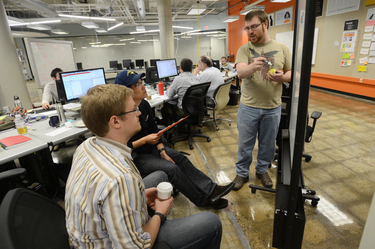Menlo Innovations still growing in underground Ann Arbor 'software factory'

Employees at Menlo Innovations work around a central table with connectivity wires hanging from the ceiling.
Melanie Maxwell | AnnArbor.com
The new space follows Menlo's "flexible workplace" philosophy, and is filled with lightweight tables, electricity and Ethernet connectivity cords that fall from the ceiling, and people working collaboratively in pairs and teams at computers that can be moved to a new location whenever the team needs a change of scenery.
“I don’t even get to choose where I sit,” co-founder and chief executive officer Rich Sheridan said.
“The corner office is over here [in the middle of the room] right now because that’s where the team put me. There’s no real corner office for the CEO and I love the energy in the room you feel from just being here in the middle of it.”
Sheridan’s spot in the middle of the open floor plan might not give him great views out of a window (the space is underground and doesn’t have any), but it does afford him the opportunity to watch his team at work.
The team Sheridan watches has continued to expand. Chief financial officer and co-founder Robert Simms said in an email that after tripling its available space with the move, Menlo has added three employees, raising its total to 21 in September. Average monthly revenues have gone up 23 percent, and monthly profits have risen 43 percent since moving into the former Tally Hall building, Simms said.

Inspirational and often amusing signs hang around the office at Menlo.
Melanie Maxwell | AnnArbor.com
“[I think] there’s a trend toward design [in the tech world],” Sheridan said.
“If you think about where high tech has gone, in the old days we were happy just to get stuff to work. Now we all carry around a computer more capable than all the computing capacity in the world when I was in college.”
In addition to his own company, from his vantage point in the middle of the “office,” Sheridan can look through a glass wall and see TechArb, the University of Michigan’s student startup accelerator. Moses Lee, assistant director of student ventures at the accelerator, said the thin separation between the spaces is invaluable for students.
“We’re trying to give students real world experience and contact with successful entrepreneurs,” he said.
“It’s amazing that they’re in this space with a glass wall that you can look through so they can literally see right through to look at practitioners of what they are trying to do.”
Menlo did not follow the same path that many other tech startups use to find early success. Rather than raising venture capital, the three co-founders, Sheridan, Simms, and chief operating officer James Goebel each wrote a check and the company “bootstrapped” its way from there.

Collaborative work is key to Menlo Innovations' philosophy of software development.
Melanie Maxwell | AnnArbor.com
“We crawled along the first few months and years, with enough to keep ourselves in our houses. To raise money we’d have had to spend all of our time explaining to people why we’re doing what we’re doing. We decided to grow more slowly and do it the way we want to.”
Menlo’s unique history and culture have led to a side-industry of “factory tours” and speaking engagements that have helped expand the reach of the company. Sheridan said there is at least one tour a day of the space, and on Menlo’s website interested visitors can sign up for workshops that range from the free one hour tour to a $1,500 five day intensive titled “Dive into the Menlo Way.”
Menlo’s old space in Kerrytown, its first “open office” experiement, will be taken over in November by Internet marketing firm Pure Visibility. Linda Girard, Pure Visibility's president, said she was inspired by Menlo's offices and wanted to use the collaborative space idea to inspire growth and change in her company.
Ben Freed covers business for AnnArbor.com. You can sign up here to receive Business Review updates every week. Reach out to Ben at 734-623-2528 or email him at benfreed@annarbor.com. Follow him on twitter @BFreedinA2


Comments
Dug Song
Wed, Oct 31, 2012 : 2:40 a.m.
I wouldn't want to work in an office without natural light myself, but if you saw Menlo's old Kerrytown offices (which also had no windows), you'd understand that this is really not a big deal for them. It's a tradeoff to be downtown, and one I'm sure they discussed at length. People have debated open floor plans forever, particularly for programmers (Peopleware vs. much of Silicon Valley) - given Menlo's culture, it's what works for them. I'm not sure I understand the mention of venture capital here - Menlo is not a high-risk, high-growth tech startup that would require (or attract) capital to cover technology or market risk. They're a software development consultancy like SRT Solutions or others in town whose business is building other people's products, or teaching them their process for doing so. Equity could be possible, but probably not altogether meaningful for a company that isn't transformational in the way startups are (with the attendant option of liquidity) - although a partnership structure with profit sharing could be done, like Zingermans: http://markmaynard.com/2012/06/ann-arbor-entrepreneurs-dug-song-and-paul-saginaw-exchange-thoughts-on-employee-ownership-and-the-meaning-of-wealth/
Linda Peck
Mon, Oct 29, 2012 : 8:02 p.m.
It is odd that there would be so much negativity about such a positive article. This company is interesting. I visited their website and it comes right out with the statement "Life is intended to be a joyful experience." There is information there about how to be successful in business and free tours, and a lot more. I was impressed and continue to be impressed with the positive energy that seems to be associated with Menlo. Why not be positive? What is the loss in that? I think if I had to look on the dark side of everything I would be depressed. I say take up the habit of joy in life. Go Menlo!
HeimerBoodle
Tue, Oct 30, 2012 : 1:18 p.m.
Oh well then, if their website says it's all cutting edge puppies and party hats then who is silly old me with my experience working in such environments to argue? To be fair, I haven't worked for Menlo directly, but I have worked for a company who used them as consultants and I've attended their trainings. Here's how that arrangement played out: the big bosses liked patting themselves on the backs for their "innovation" while the people doing the real work were forced into a paired programming development environment that was productive but hellish. And Menlo got a big fat check and got to put a large company on their list of clients. Again, my negativity comes from seeing the tole this methodology takes on workers. I could not care less what they claim in their PR campaigns.
Ron Granger
Mon, Oct 29, 2012 : 10:08 p.m.
"Life is intended to be a joyful experience." Yes, yes it is. And so we should not celebrate working in caves, packed in like sardines, when there are plenty of alternatives. And since I don't work there, I don't have to pretend working in a cave is cool, or modern, or whatever the rah rah schtick is.
Wolf's Bane
Mon, Oct 29, 2012 : 2:52 p.m.
I think sharing a computer with fellow employees is too much. I also don't like what I hear about logging each and every single hour worked in much the same manner as lawyers do; in the tech field, we think 24/7 about technology (at least the good ones), but to only get paid for onsite productivity is a sham and does not mold well with how research-centric our profession is. I took the 1500 dollar course and all I can say is, I'm glad someone else paid for it. I wish Rich and his partners continued success, but Menlo is not real-world experience.
Kool Aid
Tue, Oct 30, 2012 : 2:24 a.m.
> we think 24/7 about technology (at least the good ones) I wonder how you've any time left to consider what is "good" after spending every hour of every day thinking about technology?
Susie H.
Tue, Oct 30, 2012 : 12:13 a.m.
Who knows what they're doing when you are not around? Some people take their laptops into the bathroom with them and continue to use them while they're on the throne! Yikes!
HeimerBoodle
Mon, Oct 29, 2012 : 2:17 p.m.
Bosses always think "collaborative work environments" are great, because in the short term they are great for the bosses. People have to work together, there is self-policing of behavior, employees try to out do one another in terms of hours worked, etc. But long term they lead to burn out and low morale. Or, on the flip side, people become comfortable enough with one another that "collaboration" becomes hours spent chit chatting without real output. There's a reason that in many agile development environments, employees are "rewarded" with "alone time" away from the group. And the bosses can say all they want that they are "in the same boat" but it's very clear that they don't have to be. If Mr Sheridan decided he wanted to control where he sits, he could. The worker bees couldn't. When will executives learn that faux Aw Shucks, We Are All In this Together pandering fools no one and builds resentment?
Ron Granger
Mon, Oct 29, 2012 : 2:03 p.m.
Nothing I read in this article is new. How much equity do they give employees for the sacrifice of toiling in an austere cave? Cave workplaces are a huge drag. And a cave workspace where you sit inches away from a co-worker who just had a garlic infused Schwarma for lunch, and who didn't have time to shower in the morning. No thanks. So they are saving a lot of money by using cheap cave space. Are they pocketing the savings, or are they paying employees more? Why are people so packed if they have 17,000 sq feet? "If you think about where high tech has gone, in the old days we were happy just to get stuff to work." Is that supposed to be leadership wisdom? Because I think it is absurd.
Dug Song
Wed, Oct 31, 2012 : 2:17 a.m.
I dunno, the Pillar folks like their basement cave in the Tech Brewery just fine: http://360.io/Ku87Z9
Linda Peck
Mon, Oct 29, 2012 : 1:14 p.m.
I admire this company! First, I admire the bootstrap philosophy of using their own capital to start it, rather than looking for a loan from somebody. Second, I love the community style of working, rather than putting people into separate cubicles. It is bare bones, but it looks exciting and very functional.
HeimerBoodle
Mon, Oct 29, 2012 : 2:39 p.m.
I've worked in such environments and they are neither exciting nor functional. At best you get a good group of people who spend more time talking with one another than getting work done; at worst, you get competition, bitterness, burnout, and lack of even the modicum of privacy afforded by cube farms. Also, bad attitudes and low morale are much more contagious. When one person is unhappy, they infect others and bitterness and resentment spread like wildfire.
Brad
Mon, Oct 29, 2012 : 1:04 p.m.
One man's "flexible workplace" is another man's "substandard working conditions".
sigdiamond
Mon, Oct 29, 2012 : 1:29 p.m.
Yeah, this successful, expanding, profitable business that treats its employees as equals sounds like an absolutely miserable place to work.
A2comments
Mon, Oct 29, 2012 : 10:30 a.m.
Moving into a subterranean office has to negatively impact productivity.